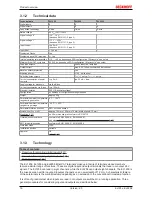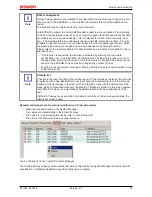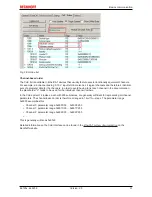
Product overview
EL125x, EL2258
17
Version: 2.5
Procedure for sampling digital inputs
•
Standard sampling
Standard sampling is used for “normal” digital input/output terminals. For the input this means that a 24
V signal (TRUE) or 0 V signal (FALSE) is applied by a sensor (e.g. light barrier). This channel
information is queried in the next EtherCAT cycle and transferred to the controller.
In addition it means that this signal was applied to the input within the last cycle time and is still present
at the time of sampling. However, no statement can be made as to the precise point in time when this
edge arrived at the input, or whether short pulses were already present before that.
Fig. 12: Query of input channel information, standard
• In Fig.
Query of input channel information, standard
pulses A and B are not picked up, only pulse C
lasts long enough to be present during sampling (blue), so that the "1" is picked up by the bus cycle.
This mode of operation is also called
frame-triggered
.
The time frame for the sampling is thus the task/EtherCAT cycle time employed of e.g. 10 ms or 1 ms.
To sample processes in the machine at finer intervals, the cycle time usually has to be reduced to the
required or smallest possible value, e.g. 100 µs. However, this entails limitations with regard to the
then maximum available computing time and possibly also the EtherCAT data volume within this cycle
time.
Two technologies are available to remedy this situation:
Oversampling
and
timestamp
.
In principle, the EtherCAT Terminals EL1258, EL1259 and EL2258 can be used for standard sampling.
•
Oversampling
Within the specified (configurable) cycle time the input terminals read the input status n times and store
the states in an array, which is transferred to the controller based on the bus cycle. The
correspondingly finer time frame, the microcycle, thus enables a slow bus cycle time with nevertheless
extremely fine sampling.
For example, the input terminal EL1262 is capable of 1000-fold oversampling at a 1 µs microcycle.
Fig. 13: Query of input channel information, oversampling
• In Fig.
Query of input channel information, oversampling
pulses A and B are also picked up, compared
with standard sampling. Over the known microcycle time each individual pulse can be determined from
the resulting data stream. However, a constantly high volume of data is transferred with each
EtherCAT cycle, even if there are no edge changes at all at the input.
Содержание EL1258
Страница 2: ......
Страница 6: ...Table of contents EL125x EL2258 6 Version 2 5...
Страница 42: ...Mounting and wiring EL125x EL2258 42 Version 2 5 Fig 36 Other installation positions...
Страница 76: ...Commissioning EL125x EL2258 76 Version 2 5 Fig 86 Incorrect driver settings for the Ethernet port...
















































